#chang and eng the siamese twins
Text


Autopsy on the bodies of Chang and Eng Bunker
#medical science#medicalcore#conjoined twins#archive#internet archive#medical illustration#g0re#image#555#the Siamese twins#chang and eng bunker
286 notes
·
View notes
Link
For the most recent episode of the CBS News podcast Mobituaries, Mo Rocca traveled to Mt. Airy North Carolina at the foothills of the Blue Ridge Mountains to attend a family reunion. It’s not Mo’s family’s reunion, but rather it’s for the Bunker family.
One reunion attendee shows off a tee shirt that was created for the event.
“Let's read the back of your shirt. It says "our family sticks together" and there's a picture of Eng and Chang on the back.”
If the names Chang and Eng Bunker don’t ring a bell, they are the famous conjoined brothers who were the original Siamese Twins. You might’ve heard of them, or seen their picture, but their story is much more than a medical case study.
Born on a houseboat in 1811 in Thailand (called Siam at the time) the boys set sail for America at the age of seventeen with a Scottish merchant Robert Hunter and an American ship captain Abel Coffin.
When they arrived at their new homeland, the twins became instant stars touring across the country.
Professor Joe Orser of University of Wisconsin Eau Claire and author of “The Lives of Chang and Eng: Siam’s Twins in Nineteenth Century America” talks about their performance.
“There were some acts of acrobatic feats that they would be asked to do. These included somersaults or lifting weights or playing badminton when each of them holding a racket and hitting the birdie back and forth. “
But they weren’t just gawked at, they were also funny and engaged their audience.
During one show, they notice a one-eyed man in the audience and tell him they’ll refund half of his admission fee because, after all, he’s only seeing half of the show.
After touring for over a decade, at the age of twenty-eight, the twins decided to settle down in rural North Carolina, and this is where the story gets really interesting.
On this podcast, Mo interviews the descendants at the Bunker reunion to help him tell this amazing story of grit and courage with many surprising twists and turns.
Mo asks Alex Sink – a descendant of Chang - why the twins’ story is important.
“I think it's an incredible, inspiring American immigration story, America was always the beacon of the place where somebody could come and build a successful life, and they came here with nothing.”
For more about the Siamese twins Chang and Eng listen to Mobituaries wherever you get your podcas
#Chang and Eng: A Messy American Dream#Chang and Eng#Mobituaries#Mo Rocca#podcast#podcasts#history#conjoined twins#thailand#siamese twins#North Carolina#immigration#1800s#Nineteenth Century#Blue Ridge Mountains#siam#asia#america#USA
1 note
·
View note
Text
NEW POST!
It's about the OG Siamese twins, Chang and Eng Bunker
I need to choose better pics for my posts
0 notes
Text
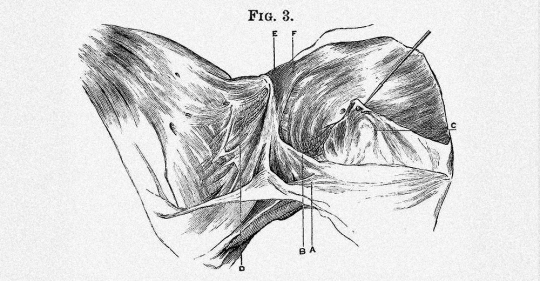


anna akhmatova tr. by judith hemschemeyer, “poem without a hero” (1990) // harrison allen, “report of an autopsy on the bodies of chang and eng bunker; commonly known as the siamese twins” (1875)
840 notes
·
View notes
Text
A bit of August 16th history… 1829 - Siamese Twins Chang and Eng...

A bit of August 16th history…
1829 - Siamese Twins Chang and Eng Bunker arrive in Boston, MA; they were 18 yrs old and came to be exhibited (pictured)
1896 - Gold 1st discovered in Klondike, Alaska
1898 - Edwin Prescott patents roller coaster
1946 - Direct Action Day: widespread riots erupt in Calcutta between Muslims and Hindus over whether Pakistan should be a separate state
1962 - Ringo Starr replaces Pete Best as Beatles’ drummer
0 notes
Note
Funny thing from lecture recently, my history prof was trying to dance around saying that a historical figure (the Siamese Twins if you're curious who it was) had sex then paused, looked at us, and went yeah they had sex fhdhdhdb
So listen, I totally get why you thought this was funny, but I would like to take the opportunity to make this a learning moment about the stigma around sex and disability.
Because on the one hand, there's this perception that people with disabilities can't/don't have sex (it must be awkward, or gross, or abled bodied people just don't want to think about it). But, if disabled people do have sex, it immediately becomes a curiosity, a topic of discussion, something to laugh at.
In this instance, it seems like the professor had some degree of discomfort with the idea that Chang Bunker and Eng Bunker (let's call them by their names and not their condition) had sex. And when the issue was discussed, it was "funny" because of the implication that this type of sex was different or strange.
Ask yourself: would this have been as much of an issue with any other historical figure? Abraham Lincoln had children, therefore he had sex. Martin Luther King Jr. had children, therefore he had sex. Same for Mark Twain and Benjamin Franklin and Albert Einstein and a hundred others.* And yet their sex is nothing remarkable.
Sex—if someone desires to have it—is part of the human experience. People with disabilities deserve to have their desire for and engagement in sex treated just like anyone else's.
My intention with pointing this out is not to imply that you or your professor are bad or wrong—I've had this exact same reaction, and I had to learn my way out of it. Think of this as a gentle invitation to look at some of your (potentially unconscious) beliefs in a new light.
-Reid
*Yes, I am aware that everyone listed here is male. Chang Bunker and Eng Bunker were both men, and so I have confined my comparisons to other men.
62 notes
·
View notes
Note
(@icetypelover) Hello, since biology is your thing I wanted to ask, how uncommon is a mutation where a Pokémon has two heads? I've seen it happen in Ekans and similar Pokémon rarely, but someone I know has a two-headed Houndoom, he was born with them. He's a gift from her father, back when he was a little Houndour pup, he's very well raised and gentle, though some fire can leak from his mouth when he's excited.
He's from a family of breeders who have been working with her father's family for generations where Houndoom are a Pokémon of choice, and they can't remember if it has ever happened before. The heads don't snap at each other and he's given a bit more food than a Houndoom his size would need since he has two brains, split in half so each head can eat, and he has no health issues.
I'm curious because there are two mythos I know, of Houndoom-like creatures with two and three heads, so it has to come from somewhere right? Since they're both represented as similar to Houndoom, does that mean it's maybe a mutation that can happen not so impossibly rare you wouldn't believe it in Houndoom?
wow, that's very fortunate that the fellow's gotten one just fine with two heads! extremely cool, what an exceptional lil guy, i'm glad the two get along.
polycephaly (literally "multiple headed") is a condition found all over the animal kingdom- including in humans!- and it isn't actually a mutation (with a notable exception we'll get to later). mutations specifically refer to changes in the genetic code- whether that's the flipping of a base pair, duplication of chromosomes, or so on- while polycephaly is actually a way that conjoined twinning can be expressed.
so, identical twins. identical (also called monozygotic) twins happen when a fertilized egg splits into two separate wholes at some point early in development- compare with "typical" development, where 1 egg + 1 sperm = 1 baby. identical twins happen when 1 egg + 1 sperm = 2 baby. compare with fraternal (or dizygotic) twins, which are formed from two separate eggs fertilized by two separate sperm. identical twins share a genetic code while fraternal twins do not (like any other sort of sibling). identical twins aren't super uncommon, though their rate of occurrence changes depending on where in the world you go.
now, usually this separation of the zygote into 2 embryos is complete. rarely, though, this splitting happens particularly late and doesn't quite finish, resulting in the two twins being connected in some fashion. this can result in an organism with one body and two heads, such as in your houndoom example, but can express in tons of different ways- for example, you may be familiar with the term "siamese twins" for conjoined twins: this originates from a famous pair of conjoined human twins from 1800's siam, chang and eng bunker, who were joined around the chest. in other cases, twins can be fused at the back of the head, the abdomen, the back, and plenty of other configurations.
survivability of these conditions varies wildly. some are easily separated, some live fine while conjoined, some must be separated for either of the two to survive, and unfortunately some are unable to survive at all, dying soon after birth.
the last case is usually what happens with two-headed organisms (something something, twice as many stars), but obviously, there are exceptions. while rare, organisms (of any sort- it's most famous in reptiles as you mentioned, but mammals (including humans!) can obviously exhibit it too) can live with these conditions as well.
also worth noting- when two complete heads are present, two complete brains are present! they may share organs and sensation, but the brains do function independently- so it's good that in your example the two get along! two-headed examples of less social species will often be much more antagonistic towards one another, since the two heads can recognize their counterparts as potential competitors or aggressors. this can cause problems in wild pokemon, who may waste precious time and energy squabbling over who gets to eat something that's going to the same stomach anyways (assuming the individuals share a stomach- sometimes there are two), leaving them vulnerable to attack.
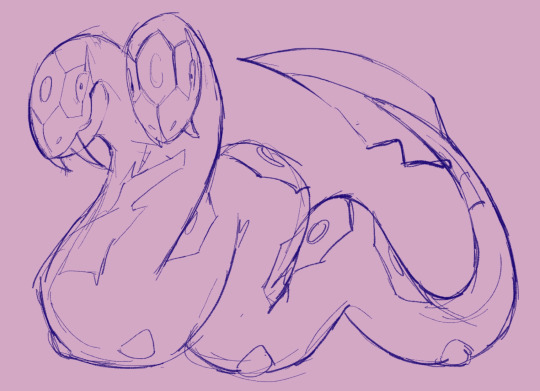
(you may be familiar with 12-string, a polycephalic seviper(s) owned by virbank gym leader roxie, who famously featured in some particularly intense PWT matches- two heads means two sets of venom glands, which means REALLY effective poison type attacks!)
this also raises the question of individuality- whether polycephalic organism(s) are considered one or two beings- and perspectives on this vary. some polycephalic twins consider themselves two separate people, while some consider themself one. in what way you consider polycephalic organisms without the ability to self-define in that way is up to you, really (which is to say, if a person with two heads considers themself one person, they are one person, and vice versa, but most nonhuman animals can't decide that for themselves and probably don't care how you refer to them).
now, uh, back to pokemon specifically, and those notable exceptions i mentioned. while polycephaly is exceptional in the vast majority of species, there are of course a few where having multiple heads is the norm: doduo/dodrio, deino/zweilous/hydreigon, and girafarig/farigiraf (there are a few others- like weezing or cherubi- but i'm talking about animals specifically here. also not to be confused with conglomerate pokemon like dugtrio or magneton, which are multiple separate individuals working as one). these instances are indeed genetically programmed.
the mechanism by which these pokemon develop their multiheadedness varies. doduo could be considered to be a conjoined twin- the zygote's partial split happens in much the same way, though enforced by genetics.
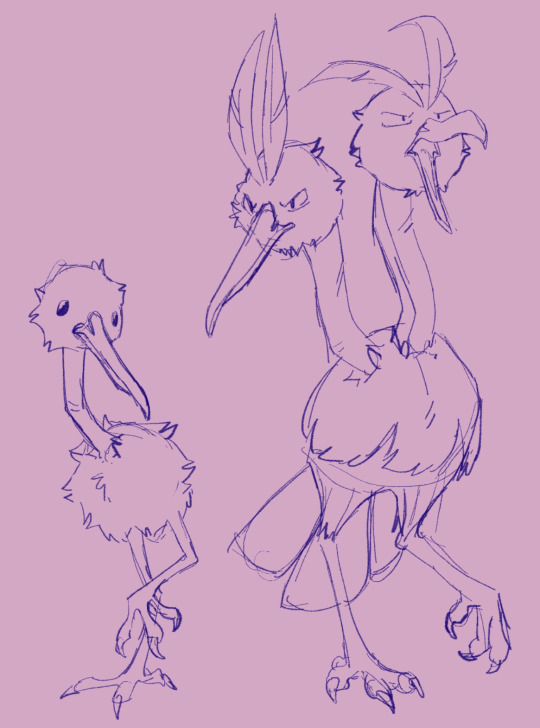
(this process can indeed lead to an inverse of polycephaly, in which the two heads of the doduo fail to separate while in development. while rare, this condition is rarely fatal, and dodrio evolving from single-headed doduo tend to be two-headed. note how the dodrio's heads are asymmetrical, with one middle and one left head.)
girafarig does not develop by partial fission- the anterior and posterior heads develop separately, just the same as you develop two of each limb, girafarig develops two heads.
in cases where a pokemon gains more heads as it evolves, such as in dodrio and zweilous, the process is somewhat similar to how it happens in embryos- the head essentially separates into two in the split-second process of instantaneous evolution, with new growth making up the material lost to each head (or in hyderigon's case, the middle head keeping all the brain). in doduo->dodrio and zweilous->hydreigon only one of the two heads separates: the right head in doduo, and the left in zweilous. you can see in the two-headed dodrio above that the singular "right" head split into the middle and right heads, leaving a "blank" space where the left head would be.
you also mentioned the various mythos surrounding multi-headed creatures- indeed, some think that mythological beasts like hades' hellish houndoom cerberus may have been inspired by real-life examples of polycephaly, though we don't know for sure. cases of polycephaly are indeed extremely rare, so it'd be entirely understandable for folks in ancient times to think they're some sort of legendary beast, and you can find records of conjoined twin animals labeled as miracles or similar in some medieval texts.
#art#pkmn#seviper#doduo#dodrio#note as said above polycephaly and other forms of conjoined twinning are real things that happen to real people and i want to handle it sen#sitively because of that. ive tried to but if anything ive said comes off as rude or callous do please call me on it#pkmn irl#pkmn rp
184 notes
·
View notes
Text

P.T. Barnum
July 5, 1810
Promoter and showman P.T. Barnum (1810-1891) was born in Bethel, Connecticut. His American Museum opened in 1842, exhibiting unusual acts such as the Feejee Mermaid, Siamese Twins Chang and Eng, and General Tom Thumb. In 1871, Barnum opened "The Greatest Show on Earth" in Brooklyn, New York. He later merged with rival J.A. Bailey to form the Barnum and Bailey Circus. Many of his quotes are still in common use today.
3 notes
·
View notes
Link
The Bunker twins, Chang and Eng, were famous conjoined twins who lived in the 1800s. Their unique situation not only made them popular exhibits but also turned "Siamese twins" into a common phrase for conjoined twins. Hailing from Siam present-day Thailand with Chinese heritage, the Bunker brothers arrived in the US in 1829. There, doctors examined them before they entered the public eye through "freak shows." By 1839, after a decade of successful touring, the twins settled down near Mount Airy, North Carolina. They became US citizens, purchased slaves , married sisters, and had 21 children together. Some of their children even joined them on later tours. Interestingly, the brothers lived in separate houses with their wives, taking turns visiting every three days. The Civil War took a toll on their finances and slaves. Tragically, Chang passed away, and Eng followed just hours later at the age of 62. An autopsy revealed their livers were connected within the ligament joining their chests. Introduction of Chang and Eng Bunker to The World Born sometime in May 1811 in Meklong, Siam (now Thailand), Chang and Eng entered the world alongside their other siblings, according to their mother. While details of their early life remain unclear, a statue in their birthplace commemorates their remarkable story.Chang and Eng's father, Ti-eye, a Chinese fisherman, sadly passed away when they were young. This might have been due to a smallpox outbreak that struck the area around 1819. Their resilient mother, Nok, took charge and raised ducks with the help of her children. Raised in the traditions of Theravada Buddhism, Chang and Eng, despite being conjoined at the chest, enjoyed a lively childhood. Their mother treated them just like their siblings, integrating them into everyday activities without making a big deal about their physical connection. Scottish merchant Robert Hunter, who enjoyed close ties with the Siamese government, is said to have first crossed paths with Chang and Eng in 1824. While initially mistaking them for an unusual creature during a chance encounter on the Menam River and the twins were swimming, Hunter soon recognized the potential to showcase the twins in the West for financial gain. In the summer of 1829, Chang and Eng, along with Scottish merchant Robert Hunter and American sea captain Abel Coffin, set sail for the United States. Their journey was planned for five years according to a contract. However, rumors arose claiming their mother had sold them into slavery, which deeply troubled the twins. Travel to the United States Landing in Boston on August 16, 1829, Chang and Eng were thrust into the public eye. Newspapers buzzed with news of their arrival, often resorting to racial stereotypes and inaccuracies. Doctors wasted no time in examining them, employing then-popular but unreliable methods like physiognomy and phrenology. Chang and Eng's initial public appearances began with a London show at the Egyptian Hall. This European tour was followed by a return to the United States, where they performed in various venues, from dime museums to smaller town inns. The length of their stay depended on location – big cities meant longer exhibitions at hotels, while smaller towns saw one or two-night showcases at local lodgings. Their manager, James W. Hale, initially called them the "Siamese Youths," a term they preferred over "boys." Ticket prices were around 25 cents (roughly equivalent to $7 today), with pamphlets and drawings of the brothers also available for purchase. Early performances focused more on physical feats like running and acrobatics. Additionally, an emphasis was placed on their exotic origins. They wore pigtails, donned "Oriental" clothing, and were billed as the "Siamese Twins." Their acts sometimes included swimming, playing games like checkers, and parlor tricks. Settling and Later Years Their nomadic exhibitions finally came to a close with a show in Jefferson, North Carolina on July 4th, 1839. A friend mentioned their desire for a quieter life, a stark contrast to the constant crowds. This prompted their move to Wilkes County, a northwestern region offering the chance to "chase stag and catch trout" – a peaceful escape they craved. In October 1839, they purchased 150 acres of land near Traphill, a rural community nestled in the mountainous northeast of Wilkes County. The land bordered Little Sandy Creek, close to the Roaring River. In 1840, Chang and Eng built a home on their Traphill property. They integrated into the local community, buying food from slaveholders and trading goods with neighbors. Their success from touring allowed them to afford a luxurious lifestyle. They even purchased slaves, with "Aunt" Grace Gates being their first, and hired household staff. By the early 1840s, their property ranked as the third most valuable in the county, valued at $1,000 (around $30,500 today). Content with their new life, they planned to permanently retire from exhibiting. Newspapers like the Carolina Watchman and the Boston Transcript reported on their newfound happiness, even labeling them as "genuine Whigs" and "happy as lords." Despite facing prejudice due to their disability and race, Chang and Eng announced their intention to marry in 1840. In 1843, they defied societal disapproval and married sisters, Sarah and Adelaide Yates, in a ceremony officiated by a Baptist preacher. While national media, particularly from the North, expressed disapproval, the local reaction seems to have been minimal, aside from a reported vandalism incident. Interestingly, the Bunker brothers would later capitalize on their unique marital situation by incorporating it into their future exhibitions. Chang and Eng's legacy extends far beyond their lives. They fathered 21 children, whose descendants now number around 1,500 as of 2006. Many of these descendants continue to reside in western North Carolina and hold annual family reunions. The Bunkers' family tree boasts several distinguished members, including Chang's descendants: Air Force Major General Caleb V. Haynes, his archaeologist son Vance Haynes, former Florida CFO and gubernatorial candidate Alex Sink, and Pulitzer Prize-winning composer Caroline Shaw. Eng's side of the family also has notable figures such as George F. Ashby, president of Union Pacific Railroad in the 1940s. Interestingly, despite having conjoined twins themselves, none of Chang and Eng's descendants have been born conjoined. However, the first set of twins born among their great-grandchildren did share the names Chang and Eng. Medical condition and Deaths Chang and Eng were born as healthy conjoined twins, a type known as xiphopagus. They were joined at the chest by a band of flexible tissue, roughly 5 inches long and stretching up to 9 inches around. This band connected their livers, and they only shared feeling in the middle section. While Eng remained healthy, Chang's health deteriorated significantly after a stroke in 1870. The stroke left most of his right side paralyzed, requiring a sling for his leg. He also developed a heavy drinking habit. In January 1874, Chang contracted bronchitis and the doctor advised him to stay home. Despite the cold weather, they traveled to Eng's house on the 15th. By the next day, Chang seemed to be improving, but he had trouble breathing at night. He insisted on sleeping upright in a chair by the fireplace. Eng, though healthy, was exhausted from caring for Chang all week and eventually asked to move to their bed after a restless night. Tragedy struck early on January 17th. When one of Eng's sons found them in the morning, Chang was already gone. Eng reportedly uttered, "Then I am going!" and passed away himself just a couple of hours later. The Bunker twins held the record for the longest lifespan of any conjoined twins in history until 2012, living a remarkable 62 years. Notably, Eng was remembered as a devoted and supportive brother, especially during Chang's declining health. Their friend, Jesse Franklin Graves, even commented on Chang's mischaracterization in the media, highlighting Eng's kindness and Chang's appreciation for it.
0 notes
Text
History
July 5, 1775- The Continental Congress adopted the Olive Branch Petition expressing hope for a reconciliation with Britain. However, King George III refused even to look at the petition and instead issued a proclamation declaring the colonists to be in a state of open rebellion.
Birthday - Civil War Admiral David Farragut (1801-1870) was born near Knoxville, Tennessee. He is best remembered for his yelling "Damn the torpedoes, full speed ahead!" during an attack on his fleet by the Confederates.
Birthday - Promoter and showman P.T. Barnum (1810-1891) was born in Bethel, Connecticut. His American Museum opened in 1842, exhibiting unusual acts such as the Feejee Mermaid, Siamese Twins Chang and Eng, and General Tom Thumb. In 1871, Barnum opened "The Greatest Show on Earth" in Brooklyn, New York. He later merged with rival J.A. Bailey to form the Barnum and Bailey Circus.
Birthday - Cecil J. Rhodes (1853-1902) was born at Bishop's Stortford, Hertfordshire, England. As a South African millionaire and politician, he was said to have once controlled 90 percent of the world's diamond production. His will established the Rhodes Scholarships at Oxford University for young scholars aged 18-25. Rhodesia was also named for him.
0 notes
Text
Tweeted
North Carolina’s Fascinating Siamese Twins In the town known for Andy Griffith, She Found Chang and Eng, the Original Siamese Twins By Jackie Sheckler Finch On a cold winter night in 1874, Eng Bunker knew he was going to die. Lying next to him https://t.co/pIETYffS6h
— GoNOMAD.com Travel (@GoNOMAD) Apr 26, 2023
0 notes
Note
My great grandparents had 21 kids all together
Chang and Eng Bunker - the Siamese twins - had 21 kids between them.
They married sisters.
Chang had 10 and Eng had 11 kids.
0 notes
Text
0 notes
Text
Chang and Eng Bunker Siamese twins - were born in the early 19th century (in 1811) at a time when medical science, was still at its infancy and the acceptable moral codes of society, were much less forgiving. World’s First Conjoined Twins born as Jun and In, they owed their life to their mother, who untwisted the ligament, connecting the babies above their waist, thus saving their lives. She reportedly did not face any difficulty during the birth, and recollected her experience, as being similar to the birth of her other children.
0 notes
Photo
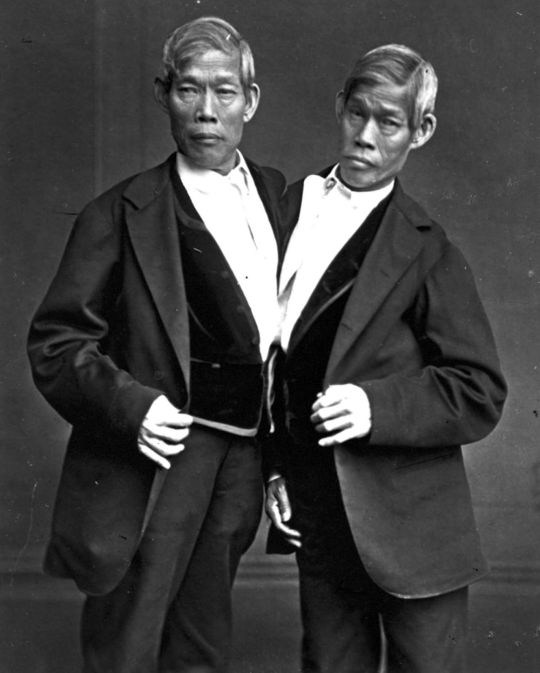
A bit of August 16th history...
1829 - Siamese Twins Chang and Eng Bunker arrive in Boston, MA; they were 18 yrs old and came to be exhibited (pictured)
1896 - Gold 1st discovered in Klondike, Alaska
1898 - Edwin Prescott patents roller coaster
1946 - Direct Action Day: widespread riots erupt in Calcutta between Muslims and Hindus over whether Pakistan should be a separate state
1962 - Ringo Starr replaces Pete Best as Beatles’ drummer
#history#anthropology#siamese twins#chang and eng#klondike gold#roller coaster#direct action day#pakistan#ringo starr
81 notes
·
View notes
Photo
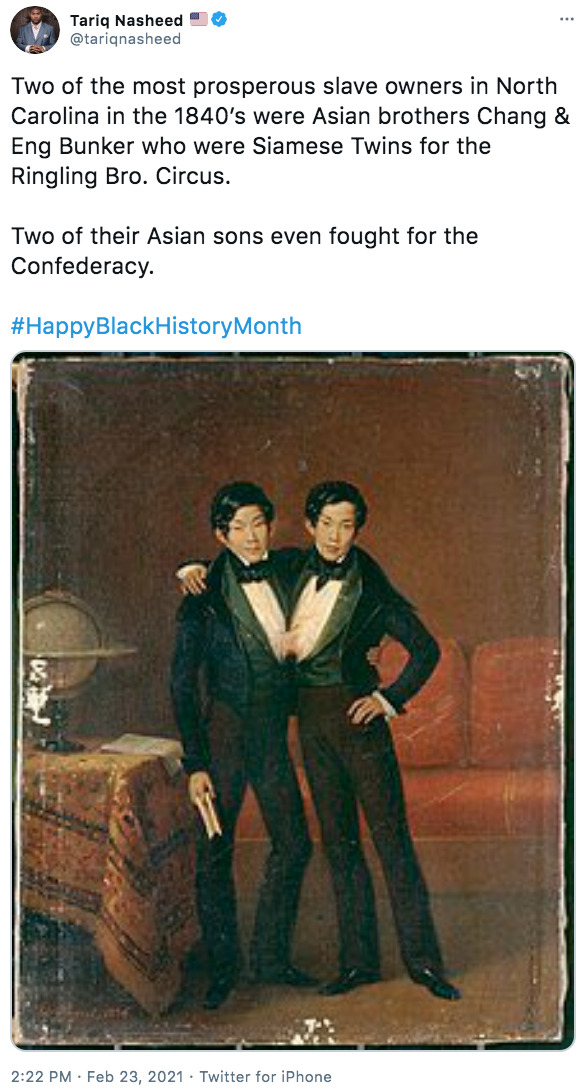
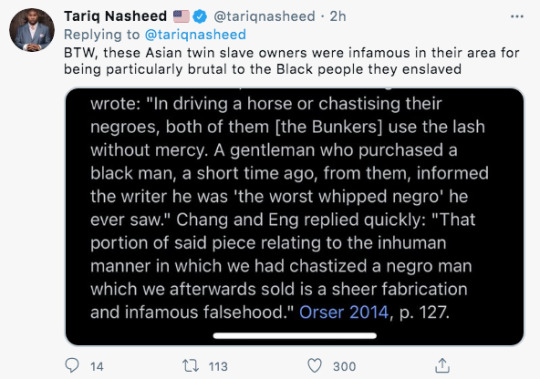
(link)
#tariq nasheed#twitter#screenshots#chang and eng bunker#siamese twins#slavery#race#black history month
1 note
·
View note